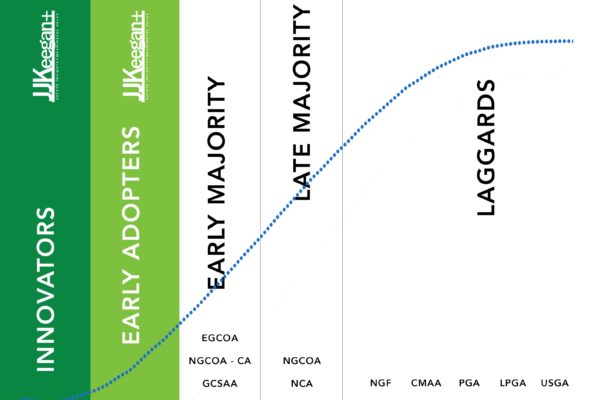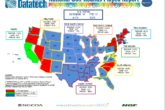
They Don’t Know The ABC’s of the Business of Golf Course Management
What do all of the Associations listed in the categories early majority, late majority and laggards have in common? The answer might amaze you.
None of them own a golf course nor have a database of golfers to which they market to increase rounds yet they control the financial destiny and investment return of over 14,000 golf course owners who have invested millions.
Can you name another sport or entertainment activity where a group of disparate Associations has control over owners whose capital is at risk?
I can’t.
It is Humorous
The current plight of the golf industry is humorous if you think about it. Those who have no capital invested in golf courses control the financial destiny of golf courses.
It just doesn’t seem right especially after I received a phone call from a highly regarded senior leader in the golf industry. The purpose of their call was multi-faceted. They indicated that they had read my blogs, “The Lessons Learned During a Lifetime,” “Sage or Critic” and “Thank You for Making My Point regarding the undue influence of Associations on the profitability of golf courses.
As gracefully and deftly as this skilled executive could, they pondered, “What Did I Hope to Achieve?”. They indicated that the Associations were the controlling influence in the industry responsible for the growth of the game and I would have little impact on the financial fortunes of golf course owners.
Your Efforts are a Fruitless Endeavor
My answer surprised them.
My audiences are the innovators and the early adopters in the golf industry. My clients are golf course owners. Many of those individuals read my newsletters and are also members of Associations. These leaders can, over time, influence the strategic vision, the tactical resources and the operating policies and procedures of the major Associations.
Business relationships I explained are not rational. They are built solely on trust. Trust is the fundamental component that brings about change.
As humans, we are social animals in which assessing, judging, and arranging are part of our core orientation. We affiliate with those that have similar values and beliefs whether it be in a community, corporation, industry or a nation.
By continual advancing new ideas in a public forum with those who I have formed a bond of trust over a period it becomes our collective goal to enhance and improve the golf industry.
By investing my time and energy, with no hopes of a personal return, we establish ourselves as thought leaders. Leadership is not a rank. Leadership is not a position. Leadership is a choice of taking risks to advance a higher cause, in this case for me, the financial success of golf course owners.
As another respected leader in the golf industry stated last week, “You are an outsider yet ironically an individual whose voice is respected though I am sure you grate against the laggards in the industry.”
The Risk of an Innovator
From this precarious vantage point, we developed the Predictive Index making over 2.0 million calculations on 44 variables rank ordering the profit potential of every golf course from 1 to 15,204. I can tell every golf course owner the amount residents spend on green fees and carts as well as merchandise, food and beverage and other activities per 18 holes within 10 miles of their course. This information the NGF and the USGA should embrace. They don’t.
We have developed a seven-step process to create a winning strategic vision for a golf course that includes 17 templates to guide the golf course operator that are listed below:
| Step | Template |
| Step 1 | Geographic Market Analysis |
| Step 2 | Weather Playable Days |
| Step 3 | Technology Integration Checkpoint |
| Step 4 | Five Year Financial Projection Daily Fee and Municipal Courses |
| Step 4 | Five Year Financial Projection Private and Resort Courses |
| Step 4 | Green Fee Calculator Quantitative Complex |
| Step 4 | Green Fee Yield Revenue Modeling Exercise |
| Step 4 | Punch Pass Subscription Fee Analysis |
| Step 4 | Season Pass Fair Fee |
| Step 4 | Season Pass Sensitivity Analysis |
| Step 5 | Annual Golf Course Labor Scheduler |
| Step 5 | Deferred Capital Expenditures Calculations |
| Step 5 | Equipment Template with Depreciation |
| Step 5 | Weekly Golf Course Labor Scheduler |
| Step 6 | Customer Value Experience |
| Step 6 | Golf Course Checklist: Secret Shopper |
| Step 7 | Golfer Survey |
These seven steps are featured in the book, “The Business of Golf – What Are You Thinking?” that has sold over 6,400 copies in 16 countries and is used by 15 Professional Golf Management programs for their capstone class.
We have developed a municipal and daily fee benchmarks quiz that provides insights on the thirteen and eleven benchmarks, respectively, that guide the success of that course. Our Customer Value Experience algorithms guide owners in establishing the proper green fee base.
These templates and the benchmarks quizzes the CMAA, LPGA, NGCOA, and PGA should embrace integrating them into their educational curriculum to enlighten their members and apprentices to be more astute professionals at their facilities. They don’t.
What is Wrong?
It is my perspective that Associations view the golf industry as a finite game and are fatally flawed in their thinking. The Golf industry is an infinite game that has no end. Someday, the incredibly talented Mike Davis at course set up will no longer be the Executive Director of the USGA. Pete Bevacqua will not head the PGA, and with Jay Karen both will be a distant but pleasant memory.
Thus, which Association may have the most influence today, the revenues they generate or the size of their membership is irrelevant. Golf is simply entertainment for the masses. Associations focus on the short-term gains of their entities with little focus on what is in the interest of the golf course owner.
Perhaps, my perspective is different. I am an explorer: curious, imaginative, resilient. I find pleasure in doing and thinking about all sorts of things and ideas. Tending to be optimistic, I see the world as a place of adventure in which I seek first-hand experiences. And, when I embark on a journey, I like to be organized, thorough and responsible though firmly grounded in reality excelling at the big picture.
Thus, the extensive research we conduct and field studies we perform reflects those values. As a prior partner in the ownership of a golf course (Arrowhead GC in Littleton, CO and a general manager at a private club (Columbian CC in Dallas, TX), this is not my first time at the dance. It is my sincere belief that I have visited more golf courses, perhaps over 4,500 in 49 countries than any other individual on this planet.
For the leading Associations to build walls, like they were an exclusive private club, dismissing the perspectives I and other qualified strategists have harmed not help the industry.
As a respected colleague highlighted, “Most of the associations are NOT run by individuals with extensive experience managing golf operations, but by professional association management people. There are a few individuals scattered throughout the organizations that were successful in that realm and have managed to move to positions with the association structure, but my experience is that most of them are frustrated from time to time as well. Just as our government is run by professional politicians and life-long bureaucrats, many of which never worked a job in the private sector or owned a small business, the associations are managed by people whose expertise is in areas outside of golf management and player development. It is very difficult for those within the “inner circle”, where the decisions are really made, to listen to or accept guidance from those who are “in the trenches.”
I believe, having a fundamental concern for the long-term health of the golf industry, it is important to continue to shake the cage hoping I can unlock and free the animals from the zoo for time is a non-redeemable commodity – once spent one never gets it back.
Thus, I believe it is important to know that thirty-four of golf courses in the US have less than 1,000 golfers per 18 holes within 10 miles. Forty-one percent of golf courses have residents who spend less than $1.0 million annual per 18 holes within 10 miles of their facility. These facilities have little long-term chance of generating a meaningful return on investment. If you have $7.5 million capital at risk, wouldn’t you want to know whether you should sell or double down? I would.
Or, if our most recent engagements are guiding clients who relied on NGF projections, borrowed millions of dollars and can’t fund the debt, are we inappropriate to suggest the NGF Consulting Division should be closed? I think not.
Obi Wan Kobi – Is there Hope?
Shouldn’t Associations take off the mask feigning they care and learn what are the relevant benchmarks that foretell success of a golf course?
I don’t that think the PGA will ever integrate our insights and perspectives from traveling over 2.8 million miles on United Airlines researching golf operations into their curriculum. I am the mosquito on the elephant’s ass as I was told several years ago. The PGA is a large labor union, like the AFL-CIO, and if it isn’t created within their sanctum, it has no value. I consistently hear from PGA Professional Golf Management instructors that the curriculum they license is sophomoric and the case study is a very basic.
I am confident that the USGA is sincerely concerned about the long-term success of golf yet believe they will never address the fundamental issues of what makes golf successful. They will narrowly focus on operational issues, i.e., maintenance and never seek to understand the more important strategic picture of demand vs. supply and what motivates individual to play the game. There is a correlation between the MOSAIC profile (attitudinal behavior) of residents within 10 miles of a golf course and the proper slope rating to attract and retain golfers.
I believe the NGF is so insulated in their research bruised from the battering of the nattering nabobs, they will never consider another perspective. I am using their data, and they have little interest in the implications of the numbers they generate or pay to obtain smoothing them as though they were the industry’s Chamber of Commerce versus an independent research organization where critical commentary is necessary. When the extremely qualified and talented Dr. Joseph Beditz retires in the next couple of years; I give them little hope of meaningful change unless there is a turnover in the staff throughout the organization. They have become very comfortable with the status quo.
Perhaps I am wrong. Do Associations offer golf course owners the solution to their issues and guide them to greater profitability? I doubt it.
That is what I think. What do you think?



John Bond
Hi Jim,
This article is extremely well-conceived in its’ questioning of how our industry is actually improving vs the game itself infatuation which the associations are obsessed with. It is very awkward for these golf associations to think in terms of how facility owners can prosper via true growth of brand new cars and customers in the parking lots and hint, news flash …. what golfing oriented entity is now selling more liquor & food and entertaining more people than ever ? And the associations posture as if they invented it and are fathers of the concept ? Getting avid golfers to play 1-2x more per month is hardly growth.
Bifurcation is now more important than ever and that is the hard-core rules and strategies from those that seriously play via high level competitions and professionally. That is the top 0.5% and yet that mindset nearly controls every aspect of our facilities. Trust me 85+% of golfers are seeking social fun, kill some time outdoors and hang with friends and oh by the way do NOT want to embarass themselves. They want to hit an OK drive and a 9 iron into a well manicured green structure. Happy people coming off of the course will spend more and come back often. Note; 110% of millenials want nothing but fun, love the outdoors and everything social ! SO … you would think golf would be their FAV activity by a wide margin. Nope; boring, hard, stupid, too serious, too many rules and what is a sin; they have no clue how gorgeous and cool the course is.
Bifurcation; 7a to 2p is for this more serious golfing crowd plus the proud avid and traditional private club members. 2p to 9p is the new ENTERTAINMENT zone that has to quickly evolve and attract all kinds of new customers (not golfers) that will enjoy ALL aspects of a 150 acre manicured park. Golf is still the marketing vehicle however it can and should be far less important as a serious game and more about fun. Incorporating new activities that 150 acres can provide; yoga, singles events, walking & running paths, small concerts, TopGolf driving range flair, tri-athlon (golf, run, bike), cycling paths, temporary sports bars on driving range and on and on and on and YES; Music !!! Oops; the fitness angle; walk 9 holes with 15lb bag = 2.2 miles … laughing with friends.
I am a 30+ yr golf industry executive, an early Ferris State PGM Graduate, an avid supporter of PGM and would love to see all these schools & graduates be the leading beacon of this new ENTERTAINMENT skillset. Hey, they are still golf professionals promoting a great game but they are also generating tons of new revenue for their owners and themselves !! Yes, golfers with Tatoo’s wearing jeans and their caps are on backwards ….. OMG. Hint; older folks that wanna be younger need these folks around ::) open their minds.
Wow, what a concept and James Keegan is 100% right.